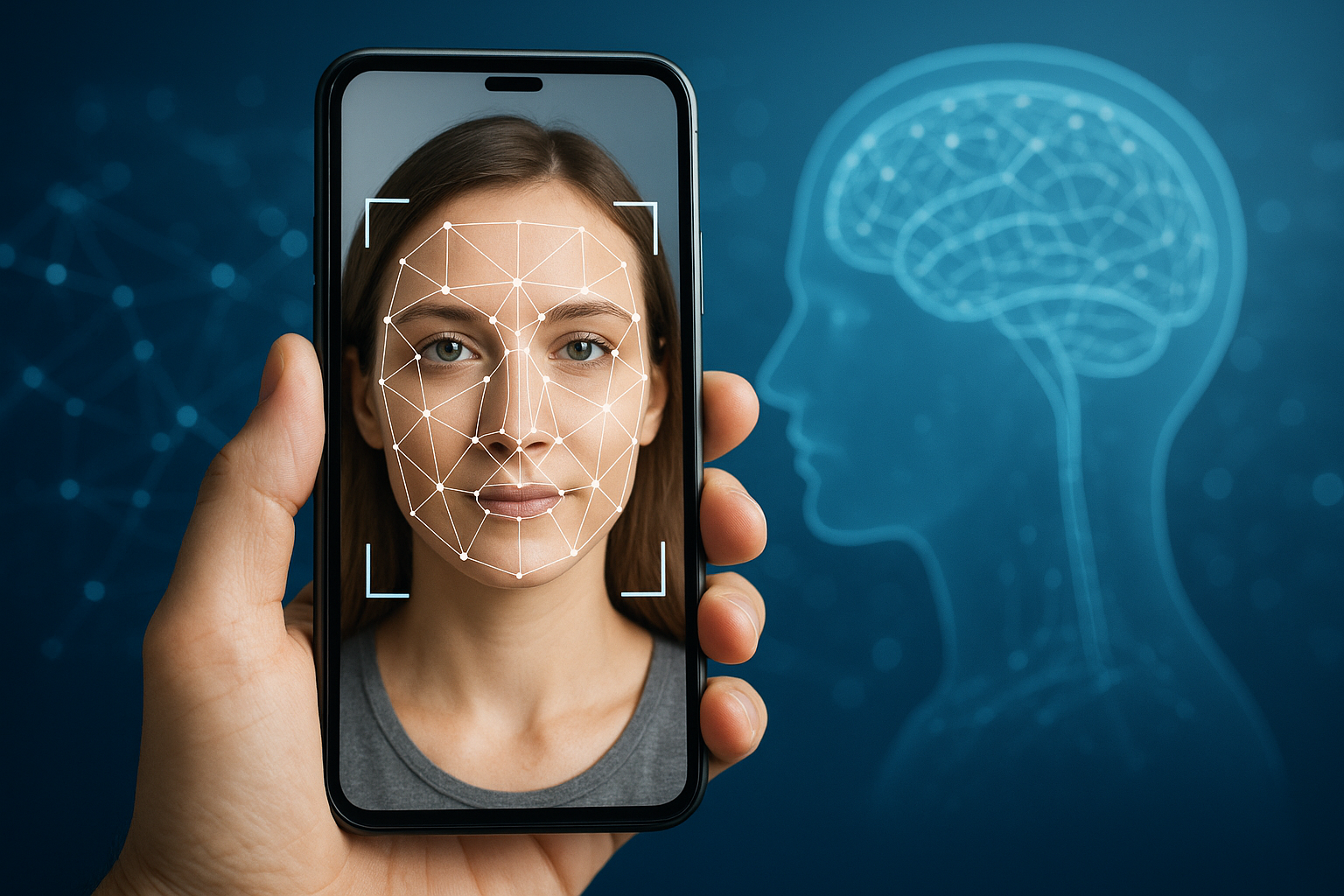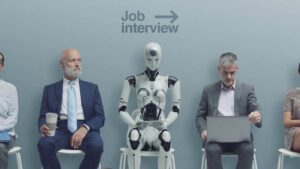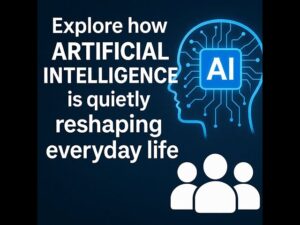
Munshif Ahamed
Most people would have laughed if someone had said twenty years ago that your phone will one day recognize your face, compose your emails, predict what you should watch next, and even alert you to traffic before you left the home. The phrase Artificial Intelligence (AI), which belonged to robot films and futuristic books, was buried in science fiction. However, it is all around us. Not as talking, walking metal creatures, but subtly integrated into the fabric of our everyday existence.
AI isn’t just a pipe dream anymore; it’s the unseen force behind a large portion of our digital environment. AI algorithms are watching, anticipating, and reacting to your activities from the time you get up and check your phone until you go to sleep and browse social media. Its presence is so potent because it is faint, almost imperceptible.

The Unnoticed Helper in Your Pocket
Let’s start with a device that you most likely use on a daily basis: your smartphone. Machine learning models operate in the background, guiding each swipe, search, and notification. The “recommended for you” list that appears when you launch YouTube or Netflix isn’t arbitrary; rather, it’s the culmination of thousands of data points, including what you’ve previously viewed, how long you watched it, when you paused, and what other users like you found enjoyable.
AI is even used in predictive and autocorrection text. When your phone completes your statement before you do, it might be a little frustrating. This is an example of neural language modelling. It gradually picks up on your writing style, including your language, tone, and punctuation, and adapts appropriately.
The most well-known examples are probably virtual assistants like Google Assistant, Alexa, and Siri. To comprehend and react to orders, they combine voice recognition and natural language processing (NLP). In milliseconds, a complicated process of voice decoding, contextual comprehension, and intent identification takes place behind what appears to be a simple “Hey Siri, play my workout playlist” request.
Healthcare AI: Beyond Convenience
While AI makes life more convenient, its greatest promise rests in change – notably in healthcare. These days, doctors rely on AI-assisted diagnostic technologies that are much faster than humans in identifying patterns in lab data, MRIs, and X-rays. These devices improve the accuracy of doctors, not replace them.
AI systems, for instance, are able to detect early indicators of conditions like diabetes mellitus or cancer before any symptoms even manifest. Predictive analytics aids in the effective management of patient loads and resources in hospitals. AI was used to simulate the virus’s propagation during the COVID-19 epidemic and even help design a vaccine.
Additionally, wearable technology, such as smartwatches, monitors your daily activities, heart rate, and sleep quality at home. AI analyses these measures, figuring out your typical habits and warning you when anything appears strange. It’s not only fitness data, though. What once needed frequent medical examinations is now practically at your fingertips.
The Revolution in the Workplace
Additionally, AI has subtly changed the workplace. Data input, scheduling, and even customer support are among the repetitive jobs that automation programs manage. Chatbots can respond to routine questions around-the-clock, freeing up human workers to do more important tasks.
Platforms for analytics powered by AI are changing how decisions are made. Managers may use data insights to forecast trends, spot issues, and maximise performance rather than relying solely on intuition or conjecture. Algorithms in marketing target consumers with near-surgical accuracy, monitor interaction, and personalise ads.
There is a flip side, though. AI’s efficiency has the potential to eliminate jobs as well. From cashiers to contact centre representatives, routine occupations are becoming more and more automated. The main issue now is not whether AI will eventually replace people, but rather how humanity will adjust. The workplace of the future will probably encourage hybrid cooperation, with AI managing speed and calculation and humans concentrating on creativity and judgement.
AI in the Home: The Age of Smart Living
AI may be found hiding in the most unlikely places in a contemporary home. Your schedule and preferred temperature are learnt by smart thermostats. Familiar faces are recognised by security cameras. Depending on what’s inside, even your refrigerator may provide recipe recommendations.
One of AI’s best features, pattern recognition, is the foundation of these systems. Your smart home gradually adapts to your way of living. As soon as you exit a room, the lights go out. Before you even sense the heat, the air conditioner makes adjustments. It’s computationally enhanced convenience.
However, privacy concerns are brought up by the convenience of smart living. Every gadget that is linked gathers information on preferences, movements, and habits. Who is the owner of the data? How safe is it? Society can no longer overlook these issues as we allow AI to infiltrate more aspects of our private lives.
The Function of AI in Creativity
Art and creativity are among the most unexpected areas of artificial intelligence. These days, machines can create digital art, write poetry, compose music, and even make films. Content production has become easier and faster thanks to tools like DALL·E and ChatGPT.
Can a machine, however, actually create? Depending on our definition of creativity, yes. Although AI cannot feel emotions, it can imitate them. Although it lacks inventiveness, it is capable of creating new things by recombining preexisting patterns. In actuality, AI enhances human creativity rather than replaces it. AI is used by musicians to try out new sounds, designers to get ideas, and writers to get over obstacles.
The Crossroads of Ethics
AI is not an exception to the rule that tremendous power comes with great responsibility. Concerns around prejudice, false information, and accountability have been brought up by the quick development of artificial intelligence. Since algorithms are only as fair as the data they are educated on, artificial intelligence will reproduce societal injustices if they are present in the data.
For example, racial bias in facial recognition systems has been criticised. Misinformation may be amplified by social media algorithms. Humanity has never confronted such moral quandaries as those presented by autonomous weaponry. Making AI more human-value-aligned is more difficult than simply making it smarter.
Ethics rules for the use of AI are now being developed by governments and tech corporations. Fairness, accountability, and transparency are emerging as the cornerstones of responsible AI. The objective is to make sure that innovation helps everyone, not just a wealthy select few, rather than to impede it.
The Future: Living Together Rather Than Competing
AI is not here to replace humans, despite all the hoopla. It lacks ambition, consciousness, and desires. It’s a tool that reflects both our finest and worst qualities. Its influence will depend on how we decide to utilise it.
The true narrative of AI is about enhancement rather than human replacement by machines. Imagine it as the invisible but essential electricity of the 20th century. AI will subtly drive healthcare, education, entertainment, and industry, making everything around us a bit quicker, smarter, and more connected.
We’re probably going to cease referring to it as “AI” in the near future. Similar to how we no longer refer to our phones as “smartphones”; they are now just phones; AI will eventually become a part of daily life. Instead of being something distinct, it will develop into a logical progression of human potential.

Concluding Remarks
The technology of the future is no longer artificial intelligence. It’s here, quietly changing the way we think, work, and live, frequently without our knowledge. Its strength comes from augmenting human potential in previously unattainable ways, not only from automation.
The challenge going ahead will be to cohabit with AI rather than govern it, creating systems that are both clever and compassionate. Because ultimately, the most intelligent technology is the one that improves us as people.